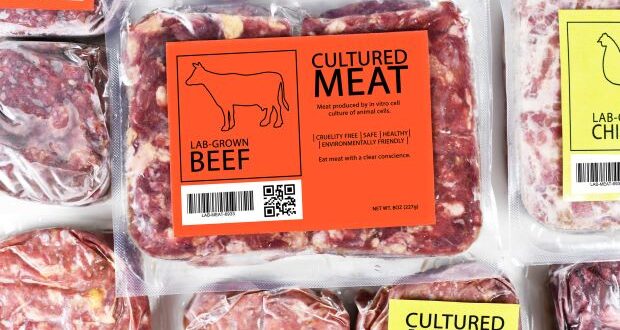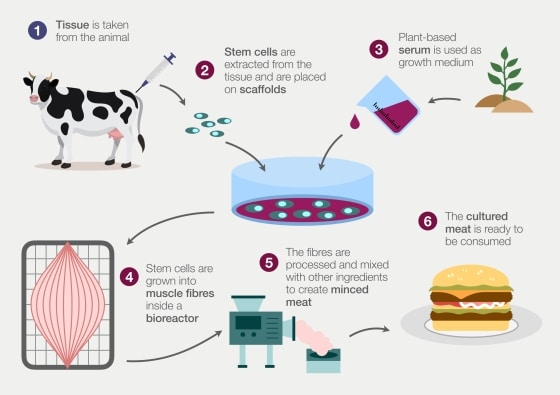It sounds like the stuff of sci-fi, growing meat in a lab, entirely skipping many of the agricultural processes many of us are familiar with today. The truth is, though – it’s already here! Lab-grown meat is no longer a science fiction concept but, in fact, a reality of today.
Still – let’s not get ahead of ourselves. Before checking your meat containers, let’s explore whether they came from a whole animal or a petri dish.
So we can better understand what lab-grown meat is, whether it’s safe or not, and why some consumers might be interested in this controversial option. And whether you’ll see this product on the shelves near you soon.
What is it?
So, the elephant in the room – what is lab-grown meat? How is it made? If it’s as simple as growing cells in a petri dish, why is it only now seeing this level of interest among food scientists and the media? Let’s explore.
Lab-grown meat, as the name implies, is primarily grown in labs – for now. Importantly, scientists must ensure the cells they produce are under strictly and carefully controlled conditions. Some advanced technologies, such as bioreactors, support these processes, which scientists use to create the conditions they need to foster cell growth.
So, where do they get the source material? In short, it depends on the specific application – but scientists can extract living cells from live animals, often without killing or significantly injuring the animal. From there, these living cells can be multiplied through cellular division under the right conditions.
Other companies are exploring the possibility of reprogramming different types of cells, such as skin cells, in a process that can induce pluripotency in them, making them useful for various applications, including growing meat in a lab. This highly novel and very young technology may advance in the coming years.
So what types of source material do they use from animals? Once again, this can vary. Firstly, different companies are researching and developing lab-grown meat, which may have other interests regarding the type of meat. Some animal companies are looking at growing tissues, including chickens, cows, and pigs – where some of the most popular meat products traditionally come from.
In addition to the different animals from which other lab-grown meat products might derive their source material, scientists might use different types of cells to create meat products. While muscle tissue is often used because meat typically contains high amounts of muscle tissue, scientists might also extract connective tissue cells and fat cells as source material.
This can enable them to create more realistic lab-grown meat that contains more of the same cellular components as traditional meat.
Is it safe to eat?
Lab-grown meat is still a relatively new technology. As such, many consumers may find themselves wondering if these types of products are safe to eat. Engineered food can be a controversial topic for some people.
It isn’t unusual for individuals to feel hesitant about trusting their health to new technologies, even if they resemble the foods we’re already used to. So, what do the experts say about the safety of these products?
The FDA:
The FDA recently cleared the way for one type of lab-grown meat in the United States. The move, which may have been surprising to some given how new this technology is, comes in the form of the FDA issuing a grant of inspection to Good Meat’s lab-grown chicken. This has been selling in Singapore since 2020 and Upsided Food’s lab-grown chicken.
This represents the first time lab-grown meat products were granted this regulatory approval in the United States. It demonstrates the FDA has reviewed and approved Good Meat and Upside Foods’ manufacturing processes. While this doesn’t mean the FDA has cleared all lab-grown meat, it does show it’s possible to create lab-grown meat products that meet the FDA’s standards.
The USDA:
Following the FDA’s decision, the USDA has cleared the sale of Good Meat’s lab-grown chicken and Upside Food’s lab-grown chicken to be sold in the United States.
Singapore Food Agency:
Singapore’s food regulatory agency, the SFA, or Singapore Food Agency, cleared the way for Good Food’s lab-grown chicken in 2020. This was the first time lab-grown meat was available to consumers, a significant technological milestone. Even more recently, GoodFoodss received regulatory approval from the SFA to sell their serum-free lab-grown meat.
Wait – what’s serum-free? That brings us to our next topic: viability and hurdles.
Challenges
There are some severe challenges to lab-grown meat. While it represents a possible avenue through which we could reduce the number of livestock animals required to grow hearts and potentially reduce our carbon footprint, there are some significant hurdles we need to address first.
Fetal Bovine Serum
Fetal bovine serum, or FBS, was a severe challenge. Scientists had trouble maintaining cell growth without certain key ingredients; one of them has often been fetal bovine serum. Fetal bovine serum, extracted from bovine fetuses, requires the slaughter or abortion of calves and represents a serious ethical concern.
Moreover, it can be prohibitive in terms of cost and viability. However, companies like Good Meat are now working on ways around the use of FBS and have had some success trying alternative methods – like the serum-free lab-grown chicken we mentioned earlier.
Environmental Concerns
The idea is simple – eliminate the need to raise animals in fields, farms, and ranches to reduce the carbon emissions in meat production. Right? Not yet. While this may be the ultimate goal of lab-grown meat, and we may get there someday, we aren’t necessarily there.
A recent study, which looked at the potential environmental impacts of lab-grown and traditional beef, found the former may have a far more significant impact on the environment for the amount of food it produces in its current incarnation. Of course, advances in science and technology could change that, but it’s essential to be mindful of how new technologies evolve.
Costs
Another severe hurdle is the cost of producing lab-grown meat. Research and development are often inherently costly pursuits, and right now, the infant technologies that support the production of lab-grown meat can be prohibitively expensive. The price of lab-grown meat can far surpass that of traditional beef, so companies may need to find ways to lower the production’s environmental impact and costs.
The Bottom Line
Lab-grown meat is here! Is it safe?
For now, the FDA thinks it can be.
Regardless, as new companies hope to sell lab-grown meat products, they’ll need to find ways to fund their research and seek regulatory approval. You may wonder if you can run to the store and try it yourself – but alas. However, although Good Meat has received regulatory approval, these products are not yet on the shelves of grocery stores at the time of writing, and only a few restaurants have announced plans to begin selling them.
Still, in the coming months, we may see the latter happen more and more. So, if you’re wondering if this is for you and your family, don’t worry. You’ve still got some time to think about it!
Do food labels guide you in your buying decision? Here’s how reading food labels can save your life.







